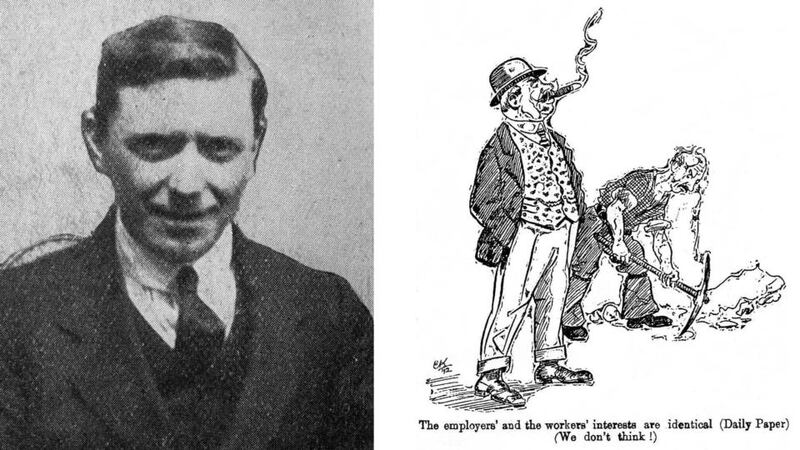During its first circulation run (1911-14) the Irish Worker newspaper, edited by Jim Larkin, enjoyed unprecedented sales for a trade union journal as it fought relentlessly "against Sweating, Poverty and Slumdom, in the sacred name of the oppressed and defenceless workers of Ireland."
Shortly after his arrival in Ireland in January 1907 Jim Larkin, then an organiser for the Liverpool-based National Union of Dock Labourers (NUDL), called for the establishment of a labour paper in Ireland that would represent the working class of the country against the prejudiced attacks endured at the hands of the mainstream “capitalist” press.
On May 27th 1911 that paper, the Irish Worker and People's Advocate, would finally be launched, with Larkin himself the editor. The Irish Worker (as it was soon renamed) was the weekly paper of the Irish Transport and General Workers' Union (ITGWU), founded by Larkin in the aftermath of his acrimonious departure from the NUDL in 1908.

For an emerging trade union still finding its feet the launch of the Irish Worker was a bold move, though the ITGWU was convinced that in 1911 there was a "universal desire which exists amongst the trade unionists and workers of Ireland for a journal entirely devoted to their interests".
This confidence was not misplaced: the Irish Worker would prove to be a fantastic success and one of Larkin's greatest achievements, sometimes selling over 20,000 copies per week at a time when all other radical newspapers in Ireland usually only enjoyed a fraction of its sales figures.
When launching the paper Larkin had told his readers that the Irish Worker would be "a lamp to guide your feet in the dark hours of the impending struggle", and it would later be impressed upon its readers that the paper was an indispensible weapon as they marched together "to battle, against Sweating, Poverty and Slumdom".
As suggested by these comments, the Irish Worker was a crusading paper of real vitality that adopted a forcefully direct journalistic style to ensure readers understood its message at all times.
Although a host of targets came under fire in its pages, the most common and memorable recipient of abuse was William Martin Murphy, who was variously described there as an “industrial octopus”, “Tramway Tyrant”, “blood-sucking vampire”, “Whited Sepulchre”, “soulless, money-grabbing tyrant” and “the most foul and vicious blackguard that ever polluted any country”.
Although Murphy and most others on the receiving end of such attacks opted to treat the paper with silent contempt, such an antagonistic style ensured that Larkin frequently found himself in court answering charges of libel as a result of material printed in the Irish Worker. Yet, tellingly, the paper never lost a case of importance and refused to ever abandon its fearless style.
Although he was the driving force and guiding spirit of the Irish Worker, writing several hundred articles and mentioned on practically every page throughout its three-and-a-half-year run, Larkin nonetheless relied on a diverse range of talented writers in order for the paper to succeed. These included the likes of James Connolly, Seán O'Casey and Standish O'Grady; while a wide array of anonymous or little known figures were also central to the paper's success.
One of the more obscure Irish Worker mainstays was the Scottish actor and writer Andrew Patrick Wilson (see also page 26), who worked as the paper's sub-editor for almost a year in the lead-up to the 1913 Lockout before going on to work as the Abbey Theatre's general manager.
Wilson was one of the Irish Worker's most versatile and entertaining writers, possessing a particular talent for using humour in a devastating fashion. His first contribution to the paper, "The Sackmender", was a striking short story which appeared at a time when the Irish Women Worker's Union led by Delia Larkin (Jim's younger sister) was involved in a dispute with a Dublin sack-making firm.
In the story a visitor wanders into a gloomy cavern to behold a “fearful old woman” mercilessly whipping a ragged, trembling girl as she sits in a huddled heap frantically sewing hundreds of sacks:
“Still the girl worked on, rapidly plying her needle, folding a finished sack and turning to another again. Her eyes were sore and red; her whole body seemed to tremble under the drudgery and toil, but when she showed the slightest inclination to halt the cruel whip lashed again, and once more she feverishly went on with the unrelenting labour. The visitor turned on the witch with a fury. ‘Why treat your slave like this?’ he asked. ‘She is not my slave,’ the witch answered, with a horrible grin; ‘she is my employee!’”
Hewas ably illustrated by Ernesst Kavanagh's cartoons – during the Lockout his ferocious depictions of William Martin Murphy as a murderous villain and the Dublin Metropolitan Police as bloodthirsty, drunken apes would feature prominently on the Irish Worker's front pages and become enduring images of the great struggle.
The paper would only cease publication following the emergence of tighter censorship regulations due to the outbreak of the first World War rather than suffering a natural demise. Larkin would later revive it briefly in America in 1916, and in Ireland during the early 1920s and 30s. These versions all enjoyed considerable success, but were unable to replicate the extraordinary success and impact of the Irish Worker during its 1911-14 heyday, when it could boast confidently of being "the best liked and the best hated paper in Ireland".
James Curry is a Digital Humanities Doctoral Scholar at the Moore Institute, NUI Galway, and the author of Artist of the Revolution. The cartoons of Ernest Kavanagh, Mercier Press, 2012.








